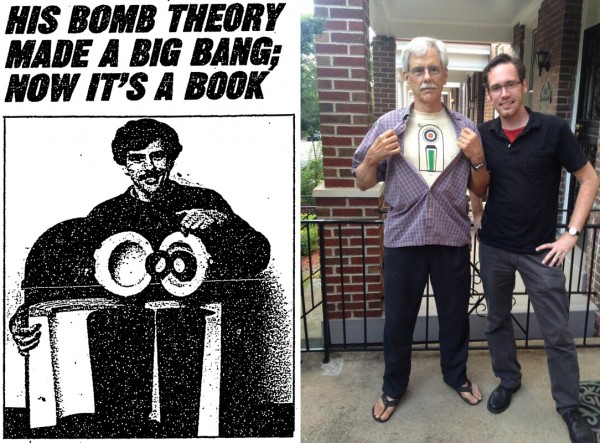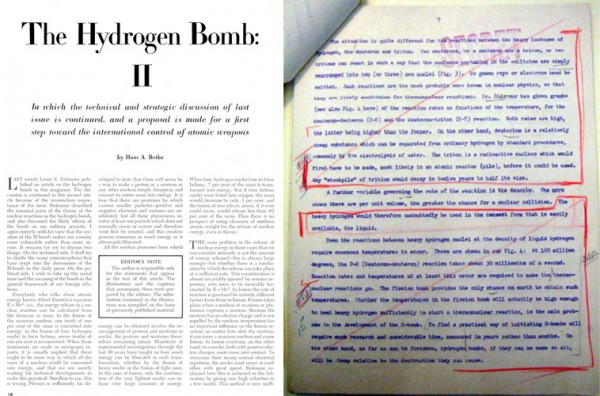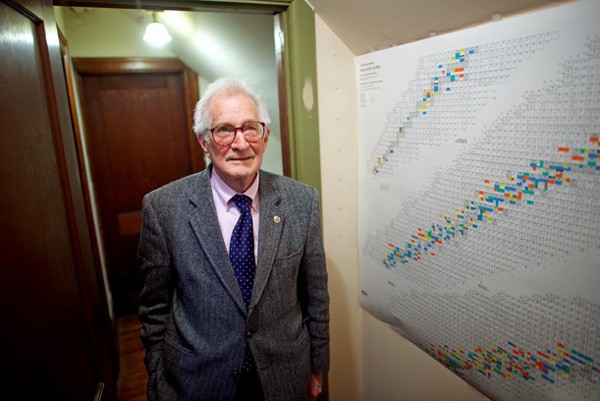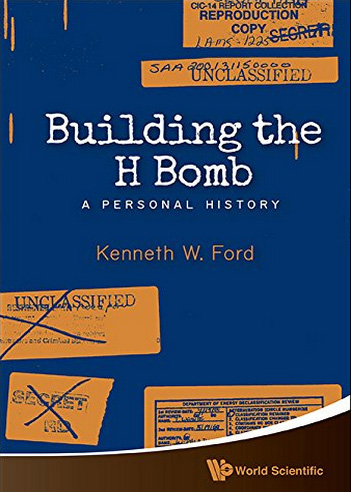Once again, the US government has gotten itself into a bad situation over the supposed secret of the hydrogen bomb. As The New York Times reported earlier this week, the Department of Energy (DOE) censors demanded that the physicist Ken Ford heavily redact a manuscript he had written on the history of the hydrogen bomb. Ford, however, declined to do so, and you can buy the unexpurgated text right now on Amazon in Kindle format, and in hardback and paperback fairly soon.
Ford was a young physicist working with John A. Wheeler during the 1950s, and so a lot of his book is a personal memoir. He is also (in full disclosure) the former head of the American Institute of Physics (my employer from 2011-2014), and I was happy to give him some assistance in the preparation of the manuscript, mainly in the form of tracking down declassified/unclassified sources relating to his story, and helped him get solid citations to them. Ken actually just recently came to Hoboken so we could iron out a few of the final citations in a Starbucks near my apartment. I knew he was having some issues with classification review, but I didn’t know he was going to play it like this — I am impressed by his boldness at just saying “no” to DOE.
Nothing I saw in his work struck me as anything actually still secret. Which is not to say that it might or might not be officially classified — just that the technical information is much the same kind of technical information you can find in other, unclassified sources, like the books of Richard Rhodes and Chuck Hansen, and people on the web like Carey Sublette, among others. And therein lies the rub: is information still a secret if it is officially classified, even if it is widely available?
This has been a tricky thing for the government to adjudicate over the years. The Atomic Energy Act of 1946 (and its revisions) charges the Atomic Energy Commission (AEC), and later the Department of Energy, with regulating “restricted data” wherever it appears, wherever it comes from. According to the law, they don’t have any choice in the matter. But over the years they changed their stance as to the best way to achieve this regulation.
One of the earliest decisions of the Lilienthal AEC was to adopt a “no comment” policy with regards to potentially sensitive information published by people unassociated with the nuclear weapons complex. Basically, if someone wanted to speculate on potentially classified topics — like the size of the US nuclear stockpile, or how nuclear weapons worked — the AEC in general would not try to get in their way. They might, behind the scenes, contact editors and publishers and make an appeal to decency and patriotism. (Sometimes this got expressed in a comical fashion: they would have “no comment” about one paragraph but not another.) But they generally did not try to use threat of prosecution as the means of achieving this end, because they felt, correctly, that censorship was too blunt an object to wield very effectively, and that telling someone on the outside of the government that they had hit upon classified information was tantamount to revealing a secret in and of itself.

Howard Morland then and now. On the left, Morland and his H-bomb model, as photographed for the Washington Post in 1981 (at the time his book account of the Progressive case, The Secret that Exploded, was published). At right, Morland and me at a party in Washington, DC, just before I moved to New York. He is wearing his H-bomb secret shirt he had made in 1979 (which he discusses in his book). I felt very honored both to see the original shirt and to see the pose he imagined he might do with it before the press, to reveal the secret to the world.
There were a few instances, however, where this “no comment” policy broke down. The best-known one is the case of United States v. Progressive, Inc. in 1979. This is the famous case in which the DOE attempted to obtain (and was briefly granted) prior restraint against the publication of a magazine that claimed to contain the “secret of the hydrogen bomb,” written by the journalist/activist Howard Morland. The DOE convinced a judge to grant a restriction on publication initially, but in the appeals process it became increasingly clear that the government’s case was on fairly shaky grounds. They declared the case moot when the researcher Chuck Hansen had a paper on hydrogen bomb design published in a student newspaper — in this case, it looked like an obvious attempt to back out before getting a bad ruling. Morland’s article appeared in print soon after and became the “standard” depiction of how the Teller-Ulam design works, apparently validated by the government’s interest in the case.
In this case, the issue was about the most egregious incursion of the Atomic Energy Act into the public sphere: the question of whether the government could regulate information that it did not itself play a part in creating. The “restricted data” clause of the Atomic Energy Act (after which this blog is named) specifies that all nuclear weapons-related information is to be considered classified unless explicitly declassified, and makes no distinction about whether said information was created in a laboratory by a government scientist or anywhere else in the world by private citizens. Thus nuclear weapons information is “born secret” according to the law (unlike any other forms of controlled national defense information), which in cases like that of The Progressive puts it in direct conflict with the First Amendment.
Ford’s book is something different, however. Ford was himself a government scientist and had a security clearance. This means he was privy to information that was most definitely classified as both “restricted data” and national defense information. He worked on Project Matterhorn B at Princeton, which was part of the hydrogen bomb effort in the early 1950s. He signed contracts that governed his behavior, both while working for the government and later. He agreed to let the government evaluate his work for classified information, and agreed he would not give away any classified information.

At left, the redacted Bethe article as published in Scientific American, April 1950. At right, the original draft, redacted by the Atomic Energy Commission (photograph taken by me at the National Archives, College Park).
There is a historical parallel here, and a better one than the Progressive case. In 1950, the magazine Scientific American ran a series of articles about the hydrogen bomb. The first of these was by the gadfly physicist Louis Ridenour. Ridenour had no connection with nuclear weapons work and he could say whatever he wanted. But the second was by Hans Bethe, who was intimately involved with classified nuclear work. Bethe obviously didn’t try to publish anything he thought was secret. But the AEC got several passages deleted from the article anyway.
The passages removed were extremely banal. For example, Bethe said that it seemed like they would need to use the deuterium-tritium reaction to achieve fusion. This level of basic information was already in the Ridenour article that was published a month before. So why delete it from the Bethe article? Well, because Bethe was connected with the government. If Ridenour says, “tritium is necessary,” it doesn’t mean that much, because Ridenour doesn’t have access to secrets. If Bethe says it, it could be potentially understood by an adversary to mean that the deuterium-deuterium reaction isn’t good enough (and it isn’t), and thus that the Los Alamos scientists had found no easy short-cut to the H-bomb. So the same exact words coming out of different mouths had different meanings, because coming out of Bethe’s mouth they were a statement about secret government research, and out of Ridenour’s mouth they were not. The whole thing became a major publicity coup for Scientific American, of course, because there is no better publicity for a news organization than a heavy-handed censorship attempt.
I have looked over a lot of Ford’s book. It’s available on Amazon as a e-book, or as a PDF directly from the publisher. I haven’t had time to read the entire thing in detail yet, so this is nothing like a formal review. The sections that I imagine drew the ire of the DOE concern some of the early thinking about how the Teller-Ulam design came about. This is an area where there is still a lot of historical ambiguity, because tracing the origins of a complex technical idea is not straightforward even without classification mucking things up. (I am working on a paper of this myself, and have a somewhat different interpretation than Ken, but that is really neither here nor there.)
There’s nothing that looks classified in Ken’s work on this to me. There are references to things that generally don’t show up in government publications, like “equilibrium conditions,” but the existence of these kinds of technical issues are common in the open literature on thermonuclear weapons, and a lot of them are present in the related field of inertial confinement fusion, which was largely declassified in the late 1990s.1
So why is the DOE pent up over Ford? It is probably not an issue of the content so much as the fact that he is the one talking about it. It is one thing for an unaffiliated, uncleared person like me to say the words “equilibrium conditions” and talk about radiation implosion and tampers and cryogenic cooling of plutonium and things of that nature. It’s another for a former weapons physicist to say it.
It’s also related to the fact that because Ken was a former weapons physicist, they have to review his work. And they have to review it against their official guides that tell them what is technically secret and what is not. And what is allowed by the DOE to talk about is not the same thing about what people on the outside of the DOE do talk about. So, for example, this is pretty much most of what the DOE considers kosher about thermonuclear weapons:
- The fact that in thermonuclear (TN) weapons, a fission “primary” is used to trigger a TN reaction in thermonuclear fuel referred to as a “secondary.”
- The fact that, in thermonuclear weapons, radiation from a fission explosive can be contained and used to transfer energy to compress and ignite a physically separate component containing thermonuclear fuel. Note: Any elaboration of this statement will be classified.
- Fact that fissile and/or fissionable materials are present in some secondaries, material unidentified, location unspecified, use unspecified, and weapons undesignated.
Now you can find a lot more elaboration on these statements in the works of Chuck Hansen, Carey Sublette, and, hell, even Wikipedia these days. (Fun fact: Howard Morland, of The Progressive case, is an active Wikipedian and contributor to that page.) And in fact there is a lot that has been released by the government that does lend towards “elaboration” of these statements, because it is impossible to full compartmentalize all of this kind of information in such neat little boxes.
But the job of the DOE reviewer was to sit down with the guide, sit down with Ken’s book, and decide what the guide said they had to do regarding the book. And in this case, it was about 10% of the book that the guide said they had to get rid of. And in this case, they are bound by the guide. Now, at a certain point, one has to say, if the guide is saying that lots of stuff that is already in Richard Rhodes’ Dark Sun, published 20 years ago, still needs to be kept under lock and key, well, maybe the guide needs to be changed. But there is arguably something of a difference between Rhodes (an outsider) writing things, and Ford (an insider) writing the same things. But it’s hard to see how any of this is going to matter with regard to national security today or in the future — it doesn’t seem like these kinds of statements are going to be what enables or disables future proliferators from acquiring thermonuclear weapons.

“How institutions appear / how institutions are.” From one of my favorite comics published on Subnormality, by Winston Rowntree. In this analogy, Ken is the beaver.
What’s amazing, again, is not that the DOE told Ken to delete things from his book. That is somewhat expected given how the classification system works. What’s amazing is that Ken told them to shove off and published it anyway. That doesn’t happen so often, that a once-insider won’t play ball. And it has no doubt put the DOE in a tough situation: they’ve set things up for a good story (like the one in the New York Times) about the silliness of government secrecy, and as a result have probably resulted in a lot of book sales that wouldn’t have otherwise happened. In this case, their attempt at preserving some form of secrecy has certainly resulted in them just calling more attention to the work in question.
What can they do to Ken? Well, technically, they probably could prosecute him under the Atomic Energy Act, or potentially the Espionage Act. But I’m pretty sure they won’t. It would be a public relations nightmare for them, would probably result in the release of even more information they deem sensitive, and Ken is no rogue agent. Which just goes to highlight one of the points I always make when I talk to people about secrecy: from the outside, it can look like government institutions are powerful and omnipotent with regards to classification. But they are usually weaker and more frail than they appear, because those who are bound by secrecy usually end up losing the public relations war, because they aren’t allowed to participate as fully as those who are on the outside.
- The Teller-Ulam design is perhaps better called the Equilibrium Super, to distinguish it from the Non-Equilibrium “Classical” Super design. In a basic sense, it refers to the fact that they were trying to achieve conditions that would result in a lot of fusion all at once, as opposed to a traveling “wave” of fusion along a cylinder of fuel. [↩]





Your post brought to mind an unsolicited manuscript that Physics Today received about SILEX (separation of isotopes by laser excitation). We didn’t publish it (because it wasn’t especially good), but I wonder if PT wouldn’t have gotten into to trouble for doing so. According to the Wikipedia entry on SILEX, the process is the only privately held information that is classified by the US government.
By the way, that same Wikipedia entry referred to The Code, an Australian Broadcasting Corporation drama series in which SILEX features as a plot element. The show’s tagline reads: “Stretching from the spectacular red desert of Australias outback to the cool corridors of power in Canberra, THE CODE tells the story of two very different brothers who unearth information that those at the highest levels of political power will kill to keep secret.”
Sounds like your cup of tea!
Dear Alex, I’ve been following your blog for a little time now and am very excited about your fascinating content. I myself am interested in the history of nuclear power and the non-proliferation of atomic weapons.
In your latest blog entry you state that:
“The “restricted data” clause of the Atomic Energy Act (after which this blog is named) specifies that all nuclear weapons-related information is to be considered classified unless explicitly declassified, and makes no distinction about whether said information was created in a laboratory by a government scientist or anywhere else in the world by private citizens. Thus nuclear weapons information is “born secret” according to the law
Hi Thomas — I think your comment got cut off.
Fascinating, and to be reading this in Moab, a mile from the DOE UMTRA project site, (uranium mine tailings clean-up) adds its own flavor. The “Uranium Building” on Moab’s main drag is now a clothing boutique!
Hey Alex. Great post, as usual!
Just one question I had – you mentioned (in the section about Bethe) that the D-D reaction isn’t good enough. As far as I know,this is the main reaction in many Teller-Ulam designed bombs, and H Bombs with pure deuterium as fuel have been used. In that case, can you explain? in the classic super, which I think was still the main idea of 1950, the D-T reactio isn’t good enough either, so I’d love to get more explanation about that point.
Please continue with your always-interesting work!
Teller-Ulam bombs post-Ivy Mike are all lithium deuteride (LiD) reactions. The lithium breeds tritium as the reaction works. So they are all D-T reactions, really, but there is an extra step. Ivy Mike was D-T in liquid form. The problem is that tritium is super expensive (in terms of money and in terms of opportunity cost — you can either make plutonium or tritium, not both), so it wasn’t sustainable to use a lot of it for weapons.
As for the Classical Super, the problem was that they were trying to use a D-T reaction to jump-start a D-D reaction. See this diagram (referenced in this post). The problem here was not getting the D-T reaction started, but whether the reaction would continue linearly down the “tube” of fuel over time. This does not work. It loses heat too rapidly (through a variety of processes) and the reaction stops. The reason for the small D-T section again is the cost of tritium.
The innovation in Teller-Ulam is to implode and ignite the entire fusion mass at once. This requires enormous compressive forces, such as those generated by radiation implosion.
Well, I checked at Carey Sublette, and he says that Mike used pure deuterium, without tritium. it is the only test that is known to use pure D.
As far as I understand, Tritium’s cost means it can’t be a main component of the fuel- which means you have to use LiD, or use it just to boost fission, or ignite other fusion reaction with it…
I would be surprised if Carey actually believed it that Mike only used pure deuterium. There is a lot of evidence to the contrary. E.g. see this interview of Harold Agnew by Richard Rhodes: “…my main involvement with Mike was with the team that put tritium in.” He goes into great detail with regards to the difficulties of using the tritium because of its scarcity, which meant they couldn’t do the sorts of tests with it that they could with deuterium, and how the tritium accidentally hydrided into the uranium in an early test, and so on.
Tritium is indeed super expensive. The reason it was used in Mike is because it was meant to be an extremely conservative proof-of-concept. They already knew about LiD at the time but it hadn’t been produced or tested very extensively. And indeed, as Bravo pointed out, their understanding of lithium fusion reactions was pretty inadequate.
Just to make something else explicit: it does not have to be a 50/50 D-T split. A perfect split would work a lot easier, but they did a lot of calculations on lower, more practical ratios for tritium. The ignition temperature required for D-D is a lot higher than D-T, so if you can get some D-T reactions going to get the temperature up, there will still be some D-D reactions.
Ford says that in the Mike bomb that there was D-T in the sparkplug, at the very least.
In The Advisors, Oppenheimer Teller & the Superbomb, pp 82, 83, Herb York says, “[Mike’s] thermonuclear fuel consisted of liquid deuterium. . .”
“There were several reasons for using . . . liquid deuterium as the thermonuclear fuel in the first major test . . .”
“It was much easier and more straightforward to understand and calculate the simple ‘burning’ of deuterium than the complex multi-step, multi-branched chain-like process involved in the explosion of LiD.”
York’s first mention of tritium in the secondary is in his description of the lithium deuteride (LiD) design, which was known at the time but not used in Mike because of its complexity. I conclude from York’s description of Mike that all of Mike’s tritium was used for fission boosting, and that D-D was perfectly adequate, if not ideal, as a thermonuclear reaction in the secondary. However, since the most compact storage form of deuterium is in LiD (unpressurized at room temperature) and LiD produces the more desirable D-T reaction, there was never a good reason to use D-D in any actual weapon design.
If Ford says something different, he may know more than York knew. (I can’t tell from the Rhodes-Agnew interview where the tritium was.)
One of the frequently repeated mantras of the security team responsible for protecting classified information is “Disclosure does not constitute declassification.” The “No comment” position recommends a response of “I can neither confirm nor deny …” to any question related to classified data, however, that response is often taken as confirmation. There is less conscious restraint on the part of the secret holder to deny a false assertion about classified information than to confirm a true (or partially correct) one.
Dr. Ford’s decision to use his own judgment to determine what can and should be published is not one many formerly cleared individuals (persons who once had security clearance) would make. I think that most feel obligated to protect the secrets intrusted to them as long as the classification (rightly or wrongly) is still in effect. I personally cannot confirm nor deny that I formerly worked with classified data, but if while I held a security clearance, I had knowledge of publicly known but still classified information, I would not choose to disclose it.
As of May 4, there are 24 reviews of Ken Ford’s H Bomb memoir on Amazon.com. And they are all three, four and five star rankings, which I assume means all of these reviews are by people who actually read the book!
Just a really positive thing there!